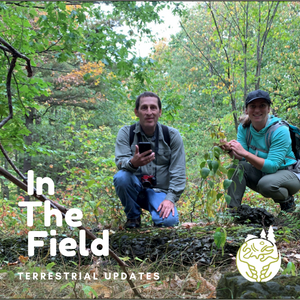This article was featured in the 2021 Autumn Newsletter by Robert Smith-SLELO PRISM
Hypena opulenta Release
This year, we completed another biocontrol release of Hypena opulenta moths. This moth is native to the Ukraine and feeds exclusively on pale and black swallowwort in its larval form. Adults were placed in 4 cages (2 at Wehle State Park, 2 at Grenadier Island) on June 1st. These cages were monitored for a new generation of Hypena larvae and defoliation of the swallowwort. Last year, 100% defoliation occurred in 4 weeks at Wehle State Park and we released the larvae from the cages. This year, the number of larvae produced was very low and this resulted in low defoliation at both sites. Since Hypena opulenta normally produce two generations per year, we decided to leave them in the cage to produce a second generation. We had never done this before, but we thought this would improve the chance that mating would occur and a larger 2nd generation would result. As can be seen in the graphs, this paid off at Grenadier Island, with defoliation of cage 1 at 20% and cage 2 at 100% after 10 weeks. Unfortunately, the cages at Wehle State Park did not produce a second generation. All 4 cages were removed on August 16. Learn more about this project on our Biocontrol Release webpage.


Black River Feasibility Study
A survey was conducted on the Black River Trail last year to determine the feasibility of invasive species removal, control, and restoration work. We divided the trail into 29 compartments and collected data such as plant species composition, abundance, and location of culverts and tributaries. Results of the survey revealed over 200 plant species are present along this trail included several tier 3 and 4 invasive species. Analysis of the data resulted in a prioritization score for each compartment. This score was based on floristic quality and can be used to manage portions of the trail according to resource limitations. These scores along with many stats such as the number of total species, woody, non-woody species, native, and invasive species are included in the newly completed Black River Feasibility Study Report. The report concluded that invasive species management and restoration are feasible if resources are designated according to compartment prioritization scores. It also recommends that removal efforts use mechanical/manual methods to limit potential chemical exposure to the public. In addition, native plant species found on the trail are recommended for use during restoration.


Summary of Suppression Work
This year, Miller’s Turf successfully completed another year of control work at 16 Priority Conservation Areas (PCAs) and multiple giant hogweed sites. Summary results are as follows:
Giant hogweed: 40 sites with no germination, 1 site root cut, 6 sites herbicide treatment, and 1 site with no permission to treat.
- Swallow-wort:77 sites on 13 PCAs, Area: 78,9 acres
- Japanese knotweed: 7 sites on 5 PCAs, Area: 0.48 acres
- Phragmites: 5 sites on 3 PCAs, Area: 0.72 acres
- Bittersweet: 3 sites on 2 PCSs, Area: 6.1 Acres
- Yellow Iris:1 site on 1 PCA, Area: 43.6 square feet
2021 Early Detection Field Survey Update
Field survey work was completed in mid-October. We surveyed around 160 Highly Probably Areas (HPAs) at 11 Priority Conservation Areas (PCAs). Aquatic surveys were completed at nine of these PCAs and Terrestrial Surveys were completed at six of these PCAs. There were many Tier 3 and 4 species found, such as swallowwort, phragmites, Japanese knotweed, Eurasian watermilfoil, European frog-bit, and many others, and we visited a couple of Tier 2 giant hogweed sites that we were aware of, but no Tier 1 species were found on any of the PCAs surveyed this year. We are currently reviewing all the data that we recorded in iMap Mobile Advanced and SAS Pro and will be creating a report that will include what we found at all the PCAs that we surveyed this year which will be uploaded to our Field Reports webpage.



